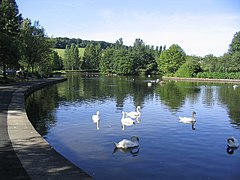| This article needs additional citations for verification. Please help improve this article by adding citations to reliable sources. Unsourced material may be challenged and removed. Find sources: "Tweedbank" – news · newspapers · books · scholar · JSTOR (October 2015) (Learn how and when to remove this message) |
| Tweedbank | |
|---|---|
 The man-made Gunknowe Loch, Tweedbank The man-made Gunknowe Loch, Tweedbank | |
 | |
| Population | 2,020 (2022) |
| OS grid reference | NT519347 |
| • Edinburgh | 29 mi (47 km) |
| • London | 303 mi (488 km) |
| Council area | |
| Lieutenancy area | |
| Country | Scotland |
| Sovereign state | United Kingdom |
| Post town | Galashiels |
| Postcode district | TD1 |
| Dialling code | 01896 |
| Police | Scotland |
| Fire | Scottish |
| Ambulance | Scottish |
| UK Parliament | |
| Scottish Parliament | |
| 55°36′11″N 2°46′01″W / 55.603056°N 2.766944°W / 55.603056; -2.766944 | |
Tweedbank is a large village south-east of Galashiels in the Scottish Borders. It is part of the county of Roxburghshire. It is an outer suburb of Galashiels, on the other (eastern) side of the River Tweed. The population of Tweedbank at the latest census is 2,101.
Geography
Tweedbank, as the name suggests, sits adjacent to the River Tweed, and approximately 500 metres (550 yd) down river from Abbotsford House, the historic home of Sir Walter Scott. Tweedbank has a pond known as Gunknowe Loch, a small shop, and a railway station.
History
The settlement was started in the early 1970s on the land of a farm whose original house still stands (serving as a boarding cattery) adjacent to the community centre (known locally as 'The Barns'). The original settlement was built by Scottish Special Housing and included the streets of Neidpath Court, Blakehope Court, Hareshaw Bank, Stobshaw Place, Stobshaw Terrace and Haining Drive. In the 1980s Bett Housing (later to be taken over by Lema Homes) began building on the site at the entry of Tweedbank from Galashiels; this estate included the streets Abbotslea, Riverside Drive, Abbotsferry Road, Lowood Park, Ladymoss and Heathery Rigg. To locals this area was often known as 'the Betts'.
The 1990s saw two developments by Eildon Housing Association, namely Jura Drive and Craw Wood, with private housing being built around Tweedbank View and Tweedbank Drive. The final development in the 2000s was constructed by Barratt Homes in the area around Weavers Linn, built on the former Abbotsford to Lowood road (later a footpath).
Before the advent of the new town of Tweedbank, the area was occupied by the farms of Tweedbank and Bridgend Mains . The new housing estate lies in the civil parish of Melrose in the former county of Roxburghshire.
Education, sport and landmarks
The original primary school near the loch was a small school of fewer than 100 pupils and composite classes. In 1996 this changed, due to a slightly increasing population, and the school was now able to teach students in separate classrooms organised by their year of schooling. In the early 2000s the school expanded due to a significant increase in the local population.
In addition to residential housing and the Primary School, Tweedbank also boasts an all weather sports complex, an Astroturf football and hockey pitch, an indoor bowling club, a large children's all-weather play area, and the Gun Knowe Loch, which is actually a man-made lake. The loch is popular with locals due to its abundance of swans and ducks. Amenities located next to the Gun Knowe Loch include a local shop, a hairdressers, and the bar/restaurant Hergés on the Loch, which has outdoor seating available in the summer. Government offices for Agriculture & Fisheries and the Scottish Public Pensions Agency can also be found within Tweedbank.
Tweedbank is the site of the biggest industrial estate in the region.
Culture
Each year in May, the village celebrates a week-long 'Tweedbank Fair' in which a local 'Tweedbank Lad and Lass' (together with two attendants each) are appointed from members of the school's Primary Seven class.
Transport

The village is served by Tweedbank railway station, the terminus of the Borders Railway that runs between the Central Borders and Edinburgh. Trains run half-hourly on weekdays, and hourly in evenings and at weekends.
Tweedbank Drive is the main thoroughfare through the village, leading from Galashiels towards Melrose, with a number of roads adjoining. Driving eastwards, on the left adjacent firstly is Abbotsferry Road. The next turn off is on the right-hand side, Weavers Linn leading to The Beeches. Other roads leading from the main thoroughfare are Cotgreen Road, Honeylees Drive, Essenside Drive, Jura Drive and Craw Wood.
See also
References
- "Mid-2020 Population Estimates for Settlements and Localities in Scotland". National Records of Scotland. 31 March 2022. Retrieved 31 March 2022.
- Census of Scotland 2011, Table KS101SC – Usually Resident Population, publ. by National Records of Scotland. Web site www.scotlandscensus.gov.uk - retrieved Oct 2016. See “Standard Outputs”, Table KS101SC, Area type: Output Area. Selecting the 16 Output Areas covering Tweedbank (east of the Tweed) on the map provided i.e. Output areas in the range S00095363-70 and S00095787-94
- Ordnance Survey map 6 in. to 1 mile: Selkirkshire Sheet VIII.NW & NE, Surveyed: 1897, Published: 1900
- Canmore website entry for Tweedbank: canmore.org.uk/site/86457 - website of the archeological inventory of Historic Environment Scotland
- Doe, Barry (27 May – 9 June 2015). "The worst National Rail timetable ever?". RAIL (775): 75.